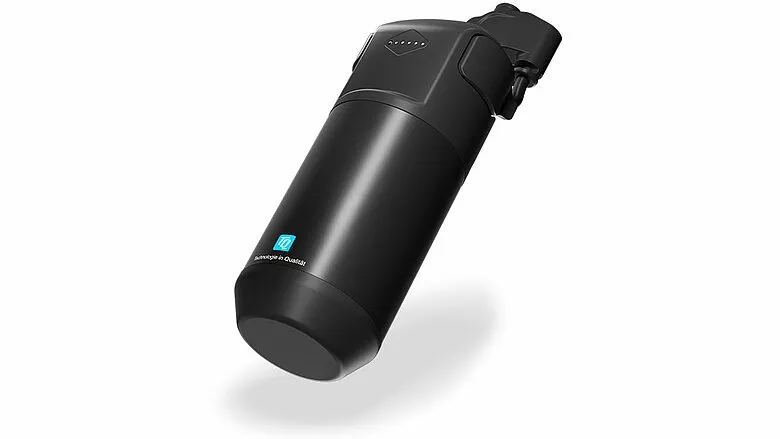People often boast the ecological prowess of ebikes, but what about their batteries?
Electric motors more efficient than internal combustion engines (ICE)
First, since ebike motors require batteries, let’s consider why employing them, instead of internal combustion engines, could be more ecological. Otherwise, we could well advocate the deployment of small internal combustion engines on bikes as well, as it was the case in the 60s in Italy (Mosquito), and in France with the Velosolex. As we already wrote here, electric energy consumption cost of an ebike battery doesn’t exceed 0.2 cents of dollar per kilometer.
An electric motor can deliver the same power as an internal combustion engine weighing less than 1/3 and being three times smaller. Open the hood of any electric car if you don’t believe it. Moreover, an electric car engine consists of roughly 200 parts, versus 2,000 parts for a car ICE. Where electricity can be easily tapped, like for electrified railways or home appliances, electric engines have replaced ICEs. Indeed, not only electric motors are much more silent and deliver better acceleration and climbing performance, but they turn into movement 80% of the energy, and only 20% into heat. For an ICE, it is roughly the opposite, 75% of the fuel energy is turned into heat, and the remaining 25% into movement, or kinetic energy. Scarce, isn’t it? The weak point of electric motors are lithium-ion, lithium phosphate, sulfur or lithium-Fe batteries: expensive, with a limited capacity, storing 13 times less energy per kilogram than fuel (although they can be inexpensively recharged, whereas fuel…) But are they also polluting?

Mercedes F-125 with lithium sulfur battery
Lithium extraction and pollution
Lithium extraction is not more polluting than the average mining activity. It does involve big water consumption and soil pollution. We cannot (yet) say whether is less or more polluting than oil and natural gas extraction, and exploring that is not within the scope of this post. That said, if are to take into account the pollution generated by oil spills and processing, lithium production and deployment could very unlikely be any worse.
Lithium mining pollution
For instance in Chile’s Salar de Atacama, a major centre of lithium production, 65% of the region’s water is consumed by mining activities. This affects farmers in the region who must then import water from other regions. The demands on water from this processing of lithium are substantial, with a ton of lithium requiring 1,900 tons of water to extract, which is consumed by evaporation (source: nature.com).
Anyway, since worldwide lithium ion battery production for electric cars is several hundred times bigger than that for ebikes, an e-car battery weighing on average hundred times more than an ebike one, the environmental impact of ebike batteries production is a far lesser concern.
Industrial usage of lithium concerns mainly lithium carbonate and lithium hydroxide
They are both produced from two main sources:
- Brines, also named salars in South America, located in the region between Argentina, Chile and Bolivia.
- Lithium minerals like Green Bushes in Australia
- They can also be extracted from geothermal brines, about 200 mg/L.
- Lithium can be extracted also from seawater, it is a byproduct of desalinization.
The world’s biggest lithium mine is in the Sonora desert, Mexico, containing reserves for 243.8 million tons, with 4.5 million tons of lithium carbonate, so 45 times the worldwide production of lithium for batteries in 2021, which was 100,000 tons. No lithium scarcity in the foreseeable future.
Can a lithium-ion battery be recycled?
Yes, and they are already recycled by huge companies as Renault, Veolia and Bosch just to name a few. Understandably, battery recycling is just at its beginning, accounting for just a small percentage of all the depleted batteries, some 4-5% worldwide. Nevertheless, there are hopes, like researchers quoted by Scientific American, alleging that not only metals of the battery can be profitably recycled, at about 95%, but replacing the cathodes can render used battery as efficient as new ones.
Unfortunately, Lithium batteries waste is polluting, and they can even catch fire when stock-piled.
Ebike battery manufacturing pollution
We already wrote here about the CO2 footprint of ebike battery production. Of course, this proceeds generates also other pollutions, just like any other industrial production, but there are so many variables rendering very difficult to reckon its magnitude. Anyway, according to the Swedish Environmental Research Institute, the total amount of CO2 emitted by battery manufacturing can range from 5.9 to 12.9 kg per 100Wh of battery capacity, ebike batteries averaging 500 Wh.
Again, if we are comparing that with car manufacturing pollution, it’s a really tiny amount.
Let me conclude with an anecdote
A few days ago a friend of mine complained for having been compelled to replace daily bike commuting with car driving because of the hilly roads of our town. I suggested buying an ebike. She replied that batteries are polluting. “Please, give me a break”, I begged.


